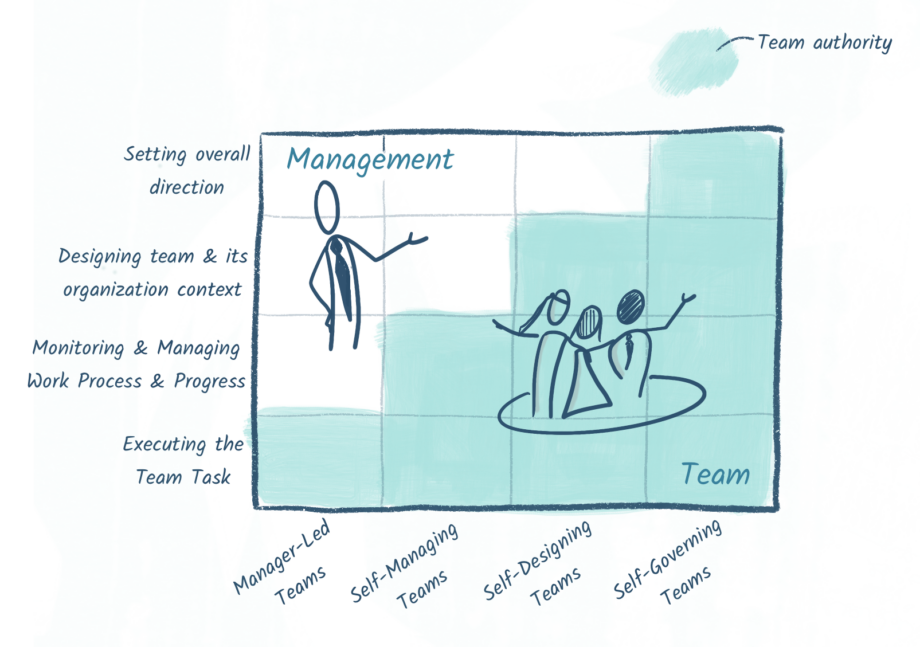A seemingly small decision can have big consequences in a growing organization. ‘Merely’ turning a team coach into a team lead may seem a very small and convenient change, but it will have a major impact and might not bring you the outcome you had in mind.
In an ideal world, the growth process in our organization goes seamlessly, with the role of team coaches becoming superfluous because teams are working well together, learning from each other, reflecting on improving their own processes, and basically working in a self-reliant manner.
Reality has shown us that there are many different types of teams. Richard Hackman’s authority matrix, from his classic Leading Teams, shows us the different ways of collaboration between management and teams.
The evolution to self-managing teams is already a big leap forward because those teams have the authority to change their own processes. However, not all teams have sufficient maturity to handle this type of authority. So it will be a learning process for management and the team members.

Easier said than done?
How to evolve from manager-led teams to stable, self-managing teams? Installing team coaches for those teams is certainly good practice. However, there are some pitfalls to be aware of and to address in order to make this a success.
Beware of the Peter Principle
What is the Peter Principle? It is a management concept developed by Laurence J. Peter, that states that we tend to promote employees based on how well they performed in previous jobs to a level where they are no longer competent. Organizations tend to select senior employees because they have more credibility to be in a management position. However, the skills needed for a specialist job are not necessarily the same as the ones needed for a management position. Seniority correlates with leadership and maturity, and yet not every senior is a good leader.
Self-fulfilling prophecy
Organizations tend to worry about the “overhead” cost associated with that Team Coach role. Besides a wrong choice of words, if you add the team coaching task to specialists’ already swamped task list, you risk them becoming an even narrower bottleneck. Adding to their workload will only increase the operational pressure. And this will result in even less time left for actual coaching of the team. You will have a situation where your team coaches will constantly be putting out fires themselves and running behind facts instead of coaching the team to learn how to deal with crisis situations on their own.
You will end up in the self-fulfilling prophecy where your team coach doesn’t have enough time to coach and the little time he has to coach, will have no impact; thus overhead.
Manager first, coach second
Combining the role of team coach and manager in 1 is possible but needs to be handled with the necessary precautions. If the mentality is ‘manager first, coach second,’ it will be very hard, even impossible to build a relationship of trust. If your behavior shows that you are controlling people’s tasks, assessing results, and evaluating performance, the sentiment that people can come to you to ‘discuss issues or ask for help’ might not be shared by the people you manage. Team members will never be completely open and will put on a ‘happy show’. This pitfall is one where trust and psychological safety suffer the most.
How do you translate this to your own growing organization?
A Team Coach drives learning capabilities and enhances team performance. We can be lyrical about team health, intrinsic motivation, happiness, and collective intelligence, but in the end, it all boils down to business outcomes.
As the organization believes in the power of coaching, it will also be no surprise that team coaches need support and coaching as well. Reality shows that organizations that start team coaching realize that people need to develop team coaching skills while already coaching teams. Although not ideal, with the right growth mindset in place, this constraint can become an opportunity where small successes lead to the momentum the organization needs to bolster its Agile growth. We suggest the following:
- Top Down: Set up an organizational learning structure where management actively mentors and coaches team coaches to become better at coaching others on a weekly basis. We assume here that upper management has the leadership competencies in place to do that.
- Bottom Up: Peer reviews are a highly effective way for developing people in their roles. The idea is that team members evaluate the team coach in his or her role. Ideally, a 360° evaluation setup can be facilitated, but this requires a minimum of psychological safety and maturity in the team. The team coach is then evaluated on key evaluation criteria that were defined at the inception of the role. If that is missing, then it is never too late to initiate a role description including evaluation criteria (e.g. communication, transparency, performance results, team health, customer outcomes, …).
There is no ‘one size fits all’-solution. Success lies in the power of the intention and the ability to reflect continuously on one’s own intentions.
If status is important to you, introspection will be hard and this status might remain your blind spot. However, if you’re open to feedback and if you let your team members evaluate you, there is definitely room for openness and trust, and an opportunity to grow together. As a team coach, apply Greenleaf’s Servant Leader test:
“The servant leader is servant first. It begins with the natural feeling that one wants to serve, to serve first. Then conscious choice brings one to aspire to lead. The best test is this: do those served grow as persons? Do they, while being served, become healthier, wiser, freer, more autonomous, more likely themselves to become servants? “. Robert Greenleaf
Conclusion
As an organization, become aware of the competencies you find indispensable for your team coaches. Other competencies like empathy, facilitation, problem identification, networking, growth mindset, systems thinking, … are more important than seniority.
Appoint your team coaches according to those skills and competencies and certainly do not forget to coach your team coaches as well, so that they can grow in their role.
Encourage your team coaches to be coaches first and leaders second. If they don’t, their impact will be limited, and a proper peer evaluation structure will highlight this.
Be aware of the fact that everything you do as a coach is an intervention that has an impact (even doing nothing), both wanted and unwanted, expected and unexpected. You are dealing with complexity, so you are not in control. However, your chances of success start to increase when you become aware of the power of intention. This requires a great deal of self-reflection, personal growth, and continuously being open to discovering and celebrating yet another blind spot.
“The success of an intervention depends on the interior condition of the intervener” – Bill O’ Brien


